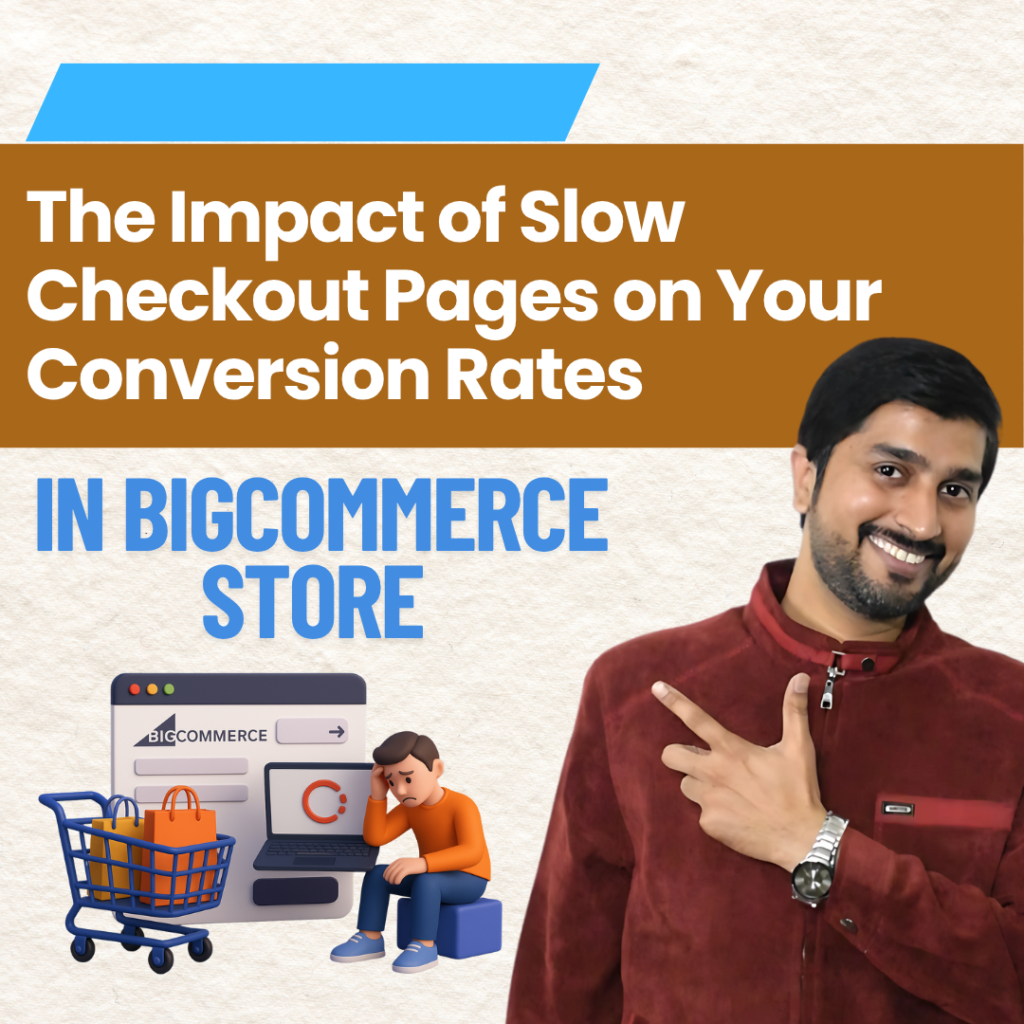Checkout friction at your store in BigCommerce Store can significantly harm your conversion rates, putting revenue and customer trust at risk. Slow-loading checkout pages are among the biggest culprits, creating unnecessary hurdles for shoppers ready to make a purchase. Understanding and addressing this issue is critical for BigCommerce store owners who want to improve their bottom line. This blog explores the effects of slow checkout pages, the drawbacks of checkout friction, and actionable strategies to optimize your store for seamless transactions.
What Is Checkout Friction, and Why Does It Matter?
Checkout friction refers to any obstacle or point of friction that interrupts or complicates the purchasing process. Slow-loading pages, excessive form fields, and unclear navigation are all examples. These issues often lead to frustrated customers abandoning their carts right before completing their transactions.
For BigCommerce store owners, addressing checkout friction is more than a technical requirement—it’s a growth strategy. Studies show that a one-second delay in page load time can result in a 7% reduction in conversions. Given that online shoppers are frequently on mobile devices and expect speed, eliminating checkout delays is crucial for boosting sales and building trust.
The True Cost of Slow Checkout Pages
Slow checkout pages don’t just annoy your customers; they directly impact your sales and long-term performance. Below are some specific ways slow pages affect BigCommerce store conversions.
1. Higher Cart Abandonment Rates
A slow-loading checkout page is one of the top reasons for cart abandonment. According to Baymard Institute, 69.99% of online shopping carts are abandoned, and slow page speeds are a significant contributing factor. For mobile shoppers, delays feel even more pronounced due to smaller device performance constraints.
Example: If you operate a BigCommerce store generating $50,000 in monthly sales, a slight increase in your cart abandonment rate caused by delays could cost thousands of dollars in lost revenue.
2. Declining Customer Trust
No one wants to input their payment information on a laggy checkout page. Shoppers often interpret these delays as technical incompetence or even a potential security risk, making them hesitant to complete their purchase. Slow checkout pages don’t just cause one lost sale—they erode the customer’s trust in your brand altogether.
3. Reduced Return Rates
Customers are unlikely to return to stores where they had a frustrating experience. First impressions matter, and slow-loading checkout pages can leave a lasting negative impression.
Key Strategies to Combat Checkout Friction at Your Store in BigCommerce Store
Addressing checkout friction at your store in BigCommerce Store involves optimizing various technical and customer experience elements. Here are actionable ways to improve website performance and reduce friction.
1. Optimize Page Load Speeds
Page speed is the backbone of an optimized checkout experience. Tools like Google PageSpeed Insights or BigCommerce’s built-in analytics can help you identify slow-loading elements and improve performance.
Pro Tip: Compress your image files, enable browser caching, and use a content delivery network (CDN) to reduce load times significantly.
2. Reduce Form Fields
Long forms are a common cause of checkout friction, particularly on mobile devices. Minimize the number of fields required for checkout. For instance, combining “first name” and “last name” fields into a single “full name” field can improve the user experience.
Why It Works: The fewer steps shoppers need to complete, the less likely they’ll abandon the process.
3. Offer Guest Checkout Options
Requiring customers to create an account before purchasing is a major turn-off. By enabling a guest checkout option, you eliminate unnecessary friction for first-time customers who simply want to complete their purchase quickly.
Pro Tip: You can always give customers the option to create an account once the transaction is complete.
4. Implement Express Checkout Solutions
BigCommerce offers integrations with express checkout solutions like Apple Pay, Google Pay, and PayPal Express Checkout. Express checkout eliminates unnecessary steps, allowing customers to pay with saved credentials in a few clicks.
5. Make Checkout Security Visible
Display SSL certifications, PCI compliance badges, and trusted third-party security seals like Norton or McAfee on your checkout page. Customers want assurance that their payment information is safe.
Why It Matters: Trust indicators help reduce hesitation, especially if customers are buying from your store for the first time.
The Drawbacks of Checkout Friction at Your Store in BigCommerce Store
Checkout friction at your store in BigCommerce Store doesn’t just frustrate shoppers—it can have lasting consequences for your business. Below are three major drawbacks you can expect if friction isn’t resolved.
1. Lost Revenue Opportunities
Every delayed or abandoned transaction represents significant lost revenue. For high-volume BigCommerce stores, even a slight increase in friction can result in thousands of dollars in unrealized profits.
2. Damaged Customer Loyalty
Once a shopper abandons their cart, your chance of recovering them diminishes drastically over time. Frustration caused by checkout friction discourages repeat purchases and deters customer referrals.
3. Competitive Disadvantages
Shoppers have plenty of options, and if a competitor offers a faster checkout experience, they’ll likely get the sale. Slow-loading pages prevent you from competing effectively in the crowded eCommerce market.
FAQs on Checkout Friction at Your Store in BigCommerce Store
1. What is checkout friction in BigCommerce stores?
Checkout friction refers to any obstacles during the payment process, such as slow pages, excessive form fields, or limited payment options, that result in cart abandonment.
2. How can I measure checkout friction?
You can analyze checkout performance using BigCommerce tools or third-party analytics like Google Analytics. Monitor metrics like load time, abandon rates, and form drop-off rates.
3. Does BigCommerce offer solutions to combat checkout friction?
Yes, BigCommerce provides several tools like one-page checkout, express payment gateway integrations, and mobile-optimized themes to reduce friction and optimize conversion rates.
4. Why do mobile users abandon checkout more frequently?
Mobile users are more impatient due to smaller screens and slower device performance. Optimizing for mobile by reducing friction points like loading delays and long forms is essential.
5. Can improving page speed help reduce checkout friction?
Absolutely. Every second counts in eCommerce. A faster-loading checkout page directly correlates with reduced abandon rates and improved customer satisfaction.
Final Thoughts
Checkout friction at your store in BigCommerce Store is more than just a technical challenge—it’s a financial one. Slow checkout pages can erode customer trust, increase cart abandonment, and hurt your revenue potential. The good news? With thoughtful optimizations like page speed improvements, guest checkout options, and express payment integrations, you can remove these barriers and create a seamless checkout experience.
Take action today! Explore how Big Commerce’s built-in tools and integrations can help you reduce checkout friction. Start optimizing your store’s performance and watch your conversions soar.



